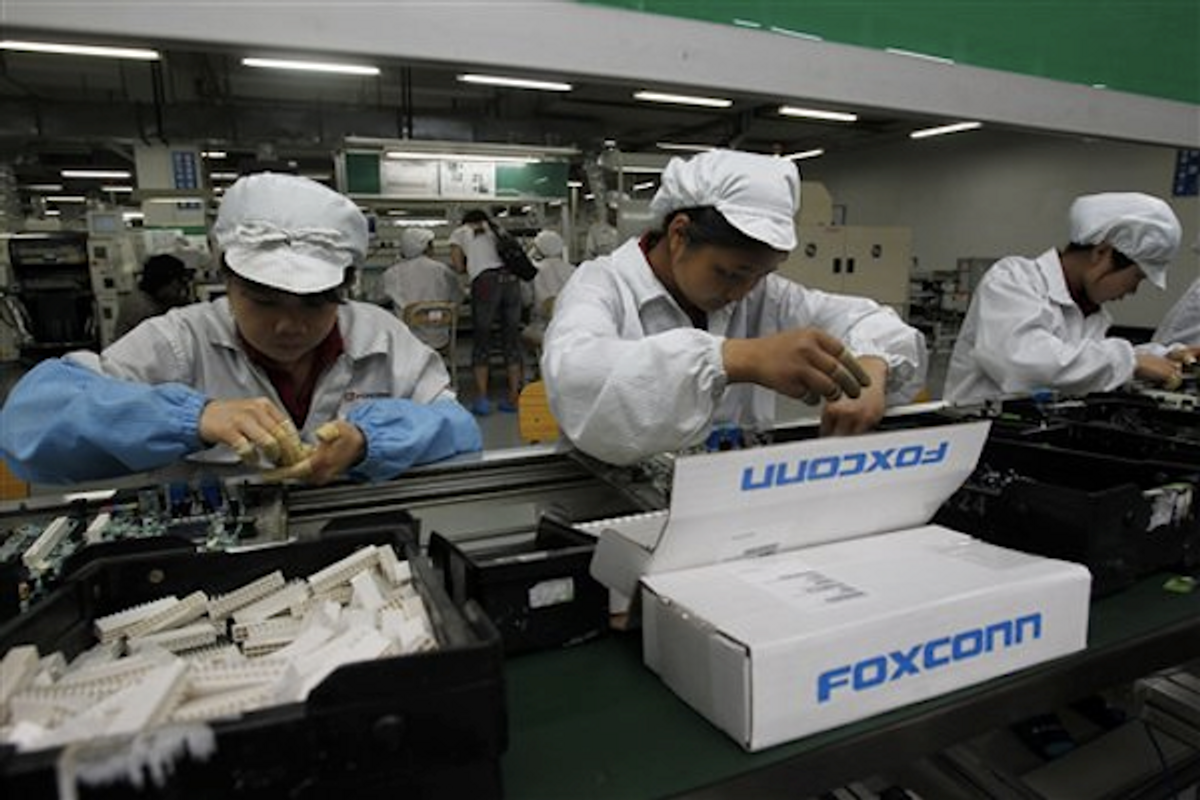People might be familiar with the name Foxconn for two reasons: It’s the company that owns the Chinese factories where iPhones are assembled, and it faced high-profile scrutiny in 2010 for a string of worker suicides that came to symbolize the often harsh working conditions in the Chinese factories producing goods Americans eagerly consume.
But this week Taiwan-based Foxconn, officially known as Hon Hai Precision Industry, is in the public spotlight for a different reason. The world’s largest contract manufacturer has teased the idea of building a massive $7 billion display-panel factory somewhere in the U.S. that would create as many as 50,000 jobs. The deal involves a partnership with Apple and would be organized through Foxconn’s Sharp Corp. unit, which is in talks with Apple to supply OLED screens for the next iPhone, according to Bloomberg.
The plan comes as President Donald Trump has threatened a huge 45 percent import tax on Chinese-produced goods and has made creation of manufacturing jobs a priority, even at the expense of disrupting long-established cross-border supply and manufacturing chains and upsetting corporate interests that support his Republican Party. The threats have companies from China’s e-commerce giant Alibaba Group to F-35 fighter jet contractor Lockheed Martin scrambling to put themselves in the president’s good graces with promises of generating U.S. jobs.
Foxconn chairman and chief executive Terry Gou has confirmed the factory proposal, which his company’s business partner Masayoshi Son, head of Japan's SoftBank Group, divulged during a meeting with Trump in December. The proposal was part of a larger announcement to invest $50 billion in the United States.
"I thought it was a private conversation, but then the next morning it was exposed," Gou told Reuters on Sunday. "There is such a plan, but it is not a promise. It is a wish."
If this wish were to come true, however, it would come at a significance upfront price to taxpayers.
Despite all the lofty praise for the wonders of capitalism and private-industry risk-takers, big factories don’t get built in the U.S. without public treasuries paying tribute in return for promises of net job creation and tax revenue gains years down the road.
State and local governments have numerous ways to make the public share the risk of major private investments, including offering companies tax rebates, sales tax exemptions and job-training grants. Even efforts to keep existing jobs can wind up costing the public revenue. Trump’s deal in December to compel air conditioner manufacturer Carrier to keep about 1,000 jobs in Indiana came with a $7 million state tax break to Carrier’s parent company, United Technologies Corp. That aerospace company earned $7.6 billion in profit on $56.1 billion in sales in 2015, according to the company’s latest annual report.
A deal that brought Tesla Motors’ massive $5 billion Nevada factory project to a site east of Reno is a likely scenario for how Foxconn would win major subsidies for any multibillion-dollar factory it would build in the U.S. In 2014 Tesla fielded bids from five states, with each offering a package of taxpayer-subsidized incentives that were kept from public scrutiny. Nevada won out and announced a nearly $1.3 billion package of tax credits and rebates in return for Tesla’s promise of 6,500 full-time factory jobs by 2020 at the massive “gigafactory” site east of Reno.
The partially operational factory, which Tesla runs in partnership with Japanese electronics company Panasonic, currently employs 1,000 workers. Some 550 more positions will soon be added, according to the Reno-Gazette. Tesla missed its job-creation target in 2015, but has insisted that it will fulfill the terms of the agreement with the state.
Critics argue these public-private deals rob states of needed tax revenue and pit states and cities against one another as they dole out generous corporate incentive offers. A 10-month analysis of business incentives by The New York Times in 2012 found that states, cities and counties were paying about $80 billion a year to subsidize private-sector investment. Texas led the way, with nearly a fourth of that sum, but while the state was dishing out subsidies to enormous multinational corporations like Dow Chemical and Texas Instruments, it was slashing public education spending and grappling with the nation’s 11th highest poverty rate.
It’s uncertain if Foxconn will actually come through with building the factory. If does, Gou has already indicated he would expect incentives.
“What we expect in the U.S. is cheap land and electricity," he said, according to Nikkei Asian Review. "I hope [the U.S.] will provide them."
With a $7 billion project on the table, Gou can rest assure there will be plenty of states that will give far more than that.



Shares